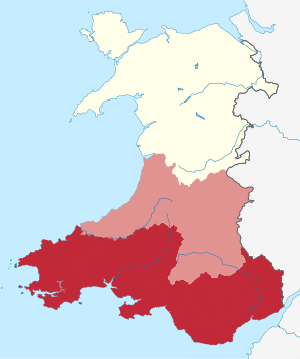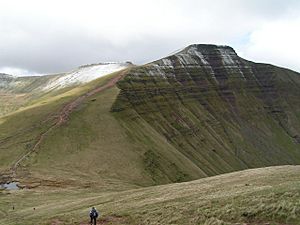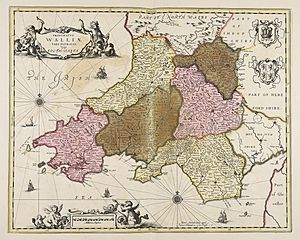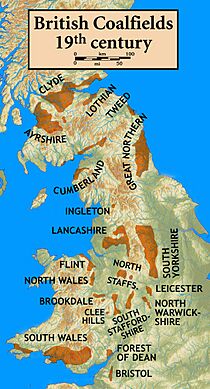South Wales facts for kids

South Wales (in Welsh: De Cymru) is a part of Wales that doesn't have exact borders. It's next to England on the east and Mid Wales to the north. Most people think it includes the old areas of Glamorgan and Monmouthshire. It also stretches west to include Carmarthenshire and Pembrokeshire. If you live west of Swansea, you might feel you're in both South Wales and West Wales.
About one-third of South Wales is covered by the Brecon Beacons National Park. This park is home to Pen y Fan, which is the tallest mountain in Britain south of Cadair Idris in Snowdonia.
There's a bit of a debate about whether to write 'south Wales' or 'South Wales'. Some style guides, like the BBC's, use 'south Wales' because it's a general area. But the Welsh Government says it should always be 'South Wales', and you'll see it capitalized on motorway signs.
Contents
History of South Wales
Between 1284 and 1535, the king's land in Wales was called the Principality of Wales. It was split into a southern and northern part. The southern part included Ceredigion and Carmarthenshire, which used to be part of the Welsh kingdom of Deheubarth (meaning 'the southern land'). The main legal office for this area was in Carmarthen. Other parts of southern Wales were controlled by powerful Marcher Lords.
In 1542, new laws created the Court of Great Sessions in Wales. This court had four legal areas. The Brecon area covered Brecknockshire, Radnorshire, and Glamorgan. The Carmarthen area covered Cardiganshire, Carmarthenshire, and Pembrokeshire. Monmouthshire was linked to the Oxford court in England. This meant these seven southern counties were different from the six northern ones.
The Court of Great Sessions ended in 1830, but the counties stayed until 1974. Then, the county of Powys was created, combining a northern county (Montgomeryshire) with two southern ones (Breconshire and Radnorshire).
So, there are different ideas about what counts as South Wales. Glamorgan and Monmouthshire are always included. But places like Breconshire or Carmarthenshire are sometimes debated. People living west of Swansea might feel they are in both South Wales and West Wales. Areas north of the Brecon Beacons and Black Mountains are usually seen as Mid Wales.
Long ago, the valleys and mountains of South Wales were very rural. They had beautiful river valleys and old forests. Poets like William Wordsworth loved this natural beauty. But this changed a lot during the early Industrial Revolution. The valleys of Glamorgan and Monmouthshire became important for coal and iron. By the 1830s, huge amounts of coal were sent by boat to ports in Cardiff and Newport. In the 1870s, coal was moved by rail transport to Newport Docks, which became the world's largest coal exporting docks. By the 1880s, coal was also shipped from Barry, Vale of Glamorgan.
The Marquess of Bute, who owned much land north of Cardiff, built a steam railway system. This railway went from Cardiff into many of the South Wales Valleys where coal was found. Lord Bute charged money for every ton of coal moved on his railways.
Because coal mining and iron smelting were the main jobs, many thousands of people moved to South Wales. They came from places like the Midlands, Scotland, Ireland, Cornwall, and even Italy. Many came from other mining areas like Somerset and the Forest of Dean. A large, skilled workforce was needed. Many of these new people settled in the South Wales Valleys between Swansea and Abergavenny. They formed English-speaking communities with their own special identity.
Workers lived in small cottages and terraced houses near the mines and factories. So many people moved in that it caused overcrowding. This led to outbreaks of diseases like Cholera. It also caused the Welsh language to almost disappear in the area.
In the 1930s, the Great Depression in the United Kingdom caused nearly half of the coal mines in the South Wales Coalfield to close. More mines closed after World War II. After the UK miners' strike (1984–85), very few mines were left. The last deep coal mine, Tower Colliery, closed in January 2008.
Even with all the industry, many parts of South Wales are still beautiful. Places like the upper Neath valley, the Vale of Glamorgan, and the valleys of the River Usk and River Wye are unspoiled. Many old industrial sites have become wild again, with cycle paths and other outdoor activities. Large areas of forests and open moorland also add to the lovely scenery.
Industrial Towns in the Past
Merthyr Tydfil's Iron and Coal
Merthyr Tydfil (in Welsh: Merthyr Tudful) grew around the Dowlais Ironworks. This factory used the rich iron ore found nearby. Soon, Merthyr became the biggest iron-producing town in the world. New coal mines were dug to feed the furnaces and later to export coal. By 1831, Merthyr's population was 60,000. This was more than Cardiff, Swansea, and Newport combined at the time! The town had coal mines, iron works, a cable factory, and more. It was also the birthplace of Joseph Parry, who wrote the famous song Myfanwy.
Heads of the Valleys Towns
Towns like Rhymney, Tredegar, and Ebbw Vale grew during the Industrial Revolution. They produced coal, metal ores, and later steel.
The Aberfan Disaster
The Merthyr Vale colliery started producing coal in 1875. Waste from the mine was piled on the hills near the village of Aberfan. This tipping continued until the 1960s. Even though the mines were owned by the government, the National Coal Board didn't realize the danger they had created. In October 1966, heavy rain made the huge coal tip unstable. A 30-foot (9-meter) high black wave of mud and coal slid downhill. It swept away houses and hit the village school. Sadly, 114 children and 28 adults were killed in the Aberfan disaster.
Rhondda Valleys' Coal Boom
The Rhondda Valleys (Rhondda Fach and Rhondda Fawr) had about 3,000 people in 1860. But by 1910, the population had jumped to 160,000! The Rhondda became the center of the huge South Wales coal industry. Accidents underground were common. In 1896, 57 men and boys died in a gas explosion at the Tylorstown Colliery. An investigation found that the mine had not been properly checked for 15 months.
Ebbw Vale's Mining History
The valley of the Ebbw River stretches from the town of Ebbw Vale to Newport. It includes mining towns like Newbridge, Risca, Crumlin, Abercarn, and Cwmcarn. The Black Vein coal seams in this area were about 900 feet (275 meters) deep. Mining here led to many tragic explosions, roof collapses, and mining accidents.
Today, the heavy industrial past of the Valleys is changing. There are efforts to rebuild and bring in tourism and new businesses. Many large factory buildings are now empty or used for shops, showing how hard it has been to replace the old industries.
Languages Spoken in South Wales
Most people in South Wales speak English. However, many also speak Welsh. In the western parts of Glamorgan, especially the Neath and Swansea Valleys, there are still many Welsh-speaking communities. Places like Ystradgynlais and Ystalyfera share a history with other former coal mining areas in eastern Carmarthenshire.
The local slang and phrases used in the South Wales Valleys are sometimes called 'Wenglish'. This dialect is also found in coastal towns like Barry, which you might know from the BBC comedy show Gavin & Stacey.
Welsh is now a required language for all students in Wales up to GCSE level. Several high schools in this area teach in Welsh. Some examples are Ysgol Gyfun Llanhari in Pontyclun, Ysgol Gyfun Y Cymmer in Porth, and Ysgol Gyfun Gwynllyw in Pontypool.
Many people from different ethnic backgrounds speak other languages as their first language, especially in Cardiff and Newport. Common languages include Punjabi, Bengali, Arabic, Somali, and Chinese. More recently, languages from Central Europe like Polish are also spoken.
In the 1800s and early 1900s, there was a strong tradition of writing and music, often linked to eisteddfodau (Welsh festivals).
Culture
- Welsh Factor is a talent competition held in Wales.
Religion
The landscape of South Wales has many chapels. These were places of worship for different Christian groups called Nonconformists. After 1662, when Anglican worship was restored, many "gathered" churches of Baptists, Independents, and Presbyterians survived. In the 1700s, some people left these churches to form new ones, like at Hengoed. In the same century, some churches joined the Methodist movement, with John Wesley often visiting places like Groeswen. The largest group became the Calvinist Methodists (now the Presbyterian Church of Wales), whose grey stone chapels are seen everywhere.
Most of these churches used the Welsh language. The Anglican church in South Wales became separate from the Church of England in 1914. There are also Brethren Assemblies in Cardiff and Swansea, and Free Presbyterian Churches in Rhiwderin and Merthyr Tydfil. The Roman Catholic community survived through tough times, especially in Brecon. Many Italian immigrants, like the Bracchi family, who ran cafes, were also Catholic.
After World War II, South Wales became more diverse. Now there are mosques, especially in Cardiff and Newport, and Sikh gurdwaras. There are also more Evangelical and Pentecostal churches. These new communities bring a strong international feel to local life. For example, the "Pont" project links Pontypridd with Mbale, Uganda, and helps create "Fairtrade" connections with producers worldwide.
Industry Today
The old heavy industries like coal and iron production have mostly gone. Many mines and factories closed in the 1970s and 1980s. By 1985, only 31 coal mines were left. The last deep mine closed in January 2008.
Now, these industries have largely been replaced by service sector jobs.
Cities along the M4 corridor are home to big companies like Admiral Insurance, Legal & General, and the Welsh-based Principality Building Society. Many telephone call centres are located in the region, especially in the Valleys. Merthyr Tydfil has the main UK call center for the mobile phone company T-Mobile. Many jobs also come from small family businesses.
One important site on the M4 corridor is Port Talbot Steelworks. It's the biggest steel producer in the UK and one of the largest in Europe.
The television and film industries are growing fast in South Wales. In 2021, the Welsh screen sector made £575 million. Major film studios have been built in Cardiff (Wolf Studios Wales, Seren Stiwdios, Enfys Studios), as well as Bridgend (Dragon Studios) and Swansea (Bay Studios).
Railways
Great Western Railway runs trains from Swansea, Cardiff Central, and Newport to London Paddington. They use modern Class 800 trains. Most train services within South Wales are run by Transport for Wales Rail. These trains use the South Wales Main Line and other local lines, like the Valley Lines.
Media
Here are some radio stations you can listen to in South Wales:
|
|
The main offices for Welsh national media, like BBC and ITV, are in Cardiff.
Gallery
-
Ogmore Castle and the countryside near Merthyr Mawr.
-
A part of the skyline in southeastern Cardiff.
-
The beach at Barry Island.
-
The Big Pit National Coal Museum at Blaenavon, showing the area's industrial past.
-
Terraced houses in Llanbradach in the South Wales Valleys.
-
The Gower and Swansea Bay Coast Path, which is part of the Wales Coast Path.
-
The seafront at Porthcawl.
-
A railway sign in Cardiff written in both English and Welsh.
See also
 In Spanish: Gales del Sur para niños
In Spanish: Gales del Sur para niños












